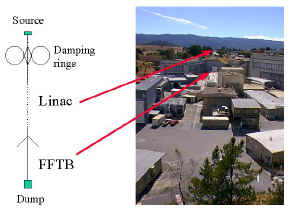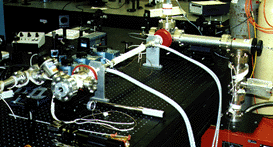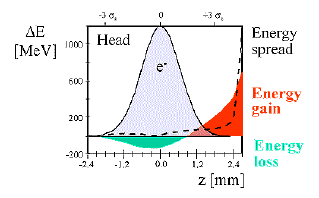|
|
|
Virtual tour of the E157
experiment
[ Why ] [ High Energy ] [ High
accelerating gradient ] [ E-157 experimental concept
] [ Location ] [ Plasma chamber ] [
Beam-plasma
interaction ] [ Energy gain/loss ] [ Plasma
focusing ] [ Summary ]
WHY
In the last 50 years particle accelerators have become important tools
to experimentally study the basic constituents of matter (elementary particles)
and the fundamental laws of nature. Many important discoveries revolutionized
our understanding of the nature of the universe and spawned many technological
applications. Though tremendous progress has been made, our present theory
of the physical world is not complete. In order to experimentally pursue
the quest for the grand unified theory ever more powerful accelerators
are needed. As present accelerator technologies start to reach their limits,
the E-157 experiment aims at studying and extending a new plasma-based
accelerator technology. [ top ]
HIGH
ENERGY An accelerator collects a
large number (billions) of well-known elementary particles (e.g. electrons
or positrons or protons, ...) into a limited volume, called a "bunch" of
particles. One or several bunches constitute the particle beam that is
being accelerated. In the process of acceleration the energy of every particle
in the beam is increased tremendously. The final beam energy of the accelerator
defines its physics potential. Due to Einstein's famous formula E =
m c2, a particle with mass m
has the energy E, with c just being the light velocity. Present
accelerators explore particle masses of up to about 150 GeV/c2.
A new particle is produced, for example, if an electron and positron, both
with an accelerated energy of 45.6 GeV collide and convert (annihilate)
into a Z-Boson with a mass of 91.2 GeV/c2.
In order to advance science into unknown regions beyond our present knowledge,
accelerators with a larger final beam energy are required. [ top
]
HIGH
ACCELERATING GRADIENT The accelerating
gradient in an accelerator describes the energy gain per acceleration length.
A given technology provides some maximum gradient. Neglecting more subtle
problems and considering a linear (straight) accelerator, a higher final
beam energy could be achieved by building a longer accelerator. However,
this approach faces practical limits in space and cost. Plasma-based acceleration
potentially provides accelerating gradients of up to 100 GeV/m. This is
more than 1000 times higher than what is achieved with conventional technology.
Proof-of-principle experiments have demonstrated those gradients over mm-lengths.
If plasma-based accelerator technology can be extended into the meter range
with a well-controlled beam-plasma interaction, a new generation of short
and ultra-powerful accelerators will become available. [ top
]
Schematic Layout of the E-157 Plasma Wakefield Acceleration
Experiment
 |
E-157
EXPERIMENTAL CONCEPT The E-157 experiment
aims at using the existing SLAC facilities to study plasma wakefield acceleration
at the forefront of advanced accelerator research. The limitations of the
existing SLAC facilities limit the achievable accelerating gradient to
about 1 GeV/m. However, the length of acceleration will be 1 m, surpassing
previous experiments by 2-3 orders of magnitude. As an appropiate sequence
of driver and witness bunch can presently not be obtained from the SLAC
linac, a single bunch is used to both drive wakefields and to witness their
accelerating effect. Therefore the experiment does not provide a useful
accelerated beam. However, it will address the questions of both long acceleration
length and control of beam quality. We hope that the results of this and
other experiments will ultimately allow to design and engineer an actual
1 m long plasma acceleration module, that provides a beam with high energy
and good quality. [ top ]
Schematic layout and photograph of SLAC facilities
 |
LOCATION
The E-157 experiment will use the existing SLAC facilities with only minor
modifications. It is going to be installed in the Final Focus Test Beam
(FFTB) facility. The experiment will be performed with the high energy,
high power electron beam from the 3 km long SLAC linac. The schematic layout
of the used facilities and a photograph of the relevant SLAC area is shown
to the right. The E-157 experiment will occupy approximately a 3 m space
in the FFTB beamline at IP-1, replacing the present E-144 (non-linear Compton
scattering) setup and two weak magnets. [ top ]
PLASMA
CHAMBER A 1 m long plasma chamber
is filled with Lithium gas. Since Lithium is a solid at room temperature
a few grams of Lithium are heated to about 600 degrees Celsius to produce
the required gas with about 100000 billion atoms per cubic cm. The following
picture shows a 0.5 m prototype of the Lithium plasma chamber at a UCLA
lab.
Photograph of a 0.5 m long plasma chamber prototype at a UCLA
lab.
 |
A laser with the right photon energy is sent through
the Lithium gas to fully singly ionize the gas and to produce the plasma.
The plasma contains an equal number of electrons and positively charged
ions. Because of their smaller mass the plasma electrons are much more
mobile than the heavy ions.
Principle of beam-driven plasma wakefield acceleration
 |
BEAM
- PLASMA INTERACTION Once the plasma
is established, a 0.6 mm long bunch of 40 billion electrons is sent into
the plasma with light velocity. The electrons are confined to a small area
with a radius of about 0.04 mm; then the bunch density is about ten times
larger than the plasma density. The space charge of the electron bunch
expels the plasma electrons (-), driving oscillations of plasma electrons
as they experience the restoring force of the plasma ions (+). The longitudinal
density modulations of plasma electrons excite strong accelerating fields.
Those fields can produce acceleration orders of magnitudes larger than
acceleration in conventional accelerating structures. [ top
]
Simulated change of energy in SLC bunch
 |
ENERGY
GAIN / LOSS Parts of the SLAC bunch
are decelerated, the electrons loose energy to the plasma electrons. However,
electrons in the tail of the bunch experience acceleration of up to 0.5-2.0
GeV, depending on the actual bunch length. A simulation for a conservative
SLC bunch length of 0.6 mm is shown below. The longitudinal electron distribution
is shown in light blue. Beam deceleration (energy loss) is indicated by
green, acceleration (energy gain) by red. The beam acceleration is evaluated
in 1 ps bins, resulting in the energy spread per slice as indicated by
the dashed line. We note that maximum beam acceleration will only affect
a small part of the beam outside of 3 standard deviations. This imposes
a challenge for measuring purposes. A different choice of plasma density
will change the number of accelerated particles with a given acceleration.
[ top ]
Simulated beam size oscillations in plasma cell
 |
PLASMA
FOCUSING The injected electron bunch
does not only experience large acceleration but also super-strong focusing
of several thousand Tesla per m. As a result the injected SLAC beam with
a radial size of about 0.04 mm will be focused to a much smaller beam size,
leading to periodic oscillations in beam size. If the bunch is extracted
at minimum beam size, it's size will grow rapidly downstream. It is best
extracted at maximum beam size, allowing for the best beam diagnostic downstream.
[ top ]
SUMMARY
The experiment E-157 will carefully study beam-plasma interaction over
lengths that are more than 100 times beyond those realized today. We will
measure ultra-high gradient acceleration and beam focusing. Due to the
limitations of the SLAC beam, the experiment does not provide a useful
accelerated beam. However, it addresses the important questions of how
to extend plasma wakefield acceleration to the meter scale and how to preserve
the beam quality. We hope that the results of this and other experiments
will allow to design and engineer an actual 1 m long plasma acceleration
module, that provides a beam with high energy and good quality. Such a
module will certainly find a broad range of applications in basic and applied
research. [ top ] |

